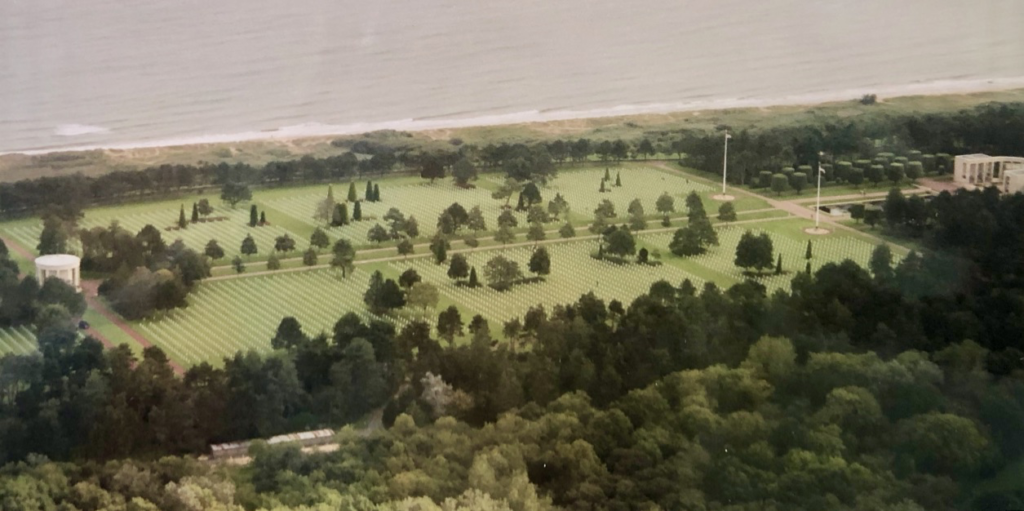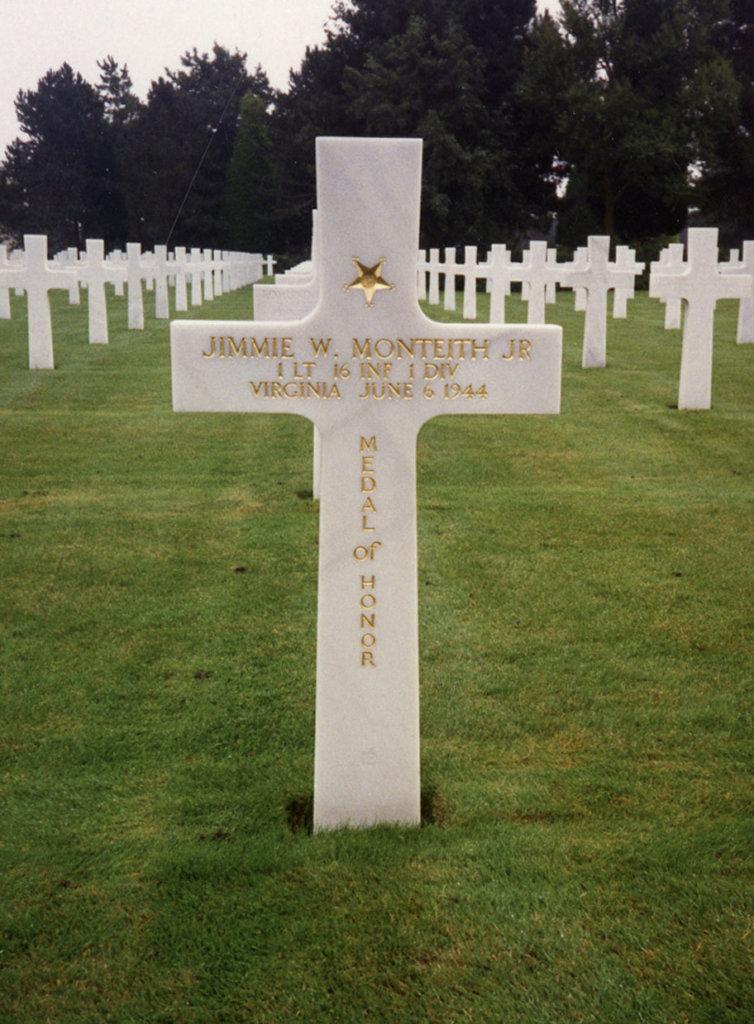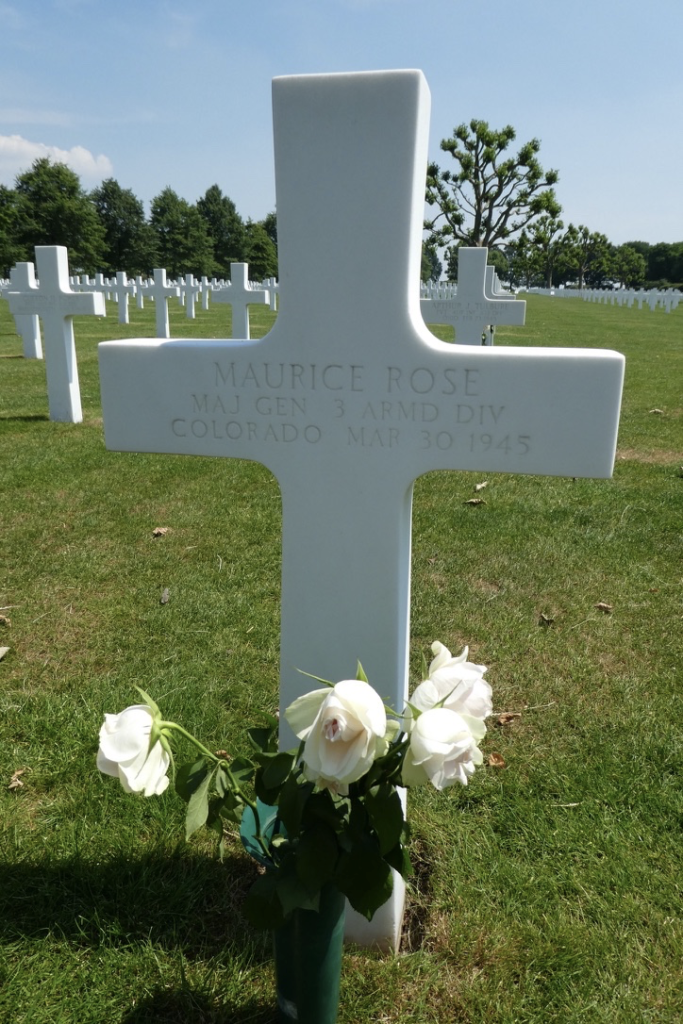On all of our visits to Europe we always make a point of visiting US military cemeteries, as well as those of Britain, Canada, France, Poland, Belgium, and Germany. We have never made a trip to Normandy without spending half a day or so at the Normandy American Cemetery and Memorial above Omaha Beach, and often also the Brittany American Cemetery near Saint-James near the border between Brittany and Normandy. Each of these visits has been a memorable experience and being present at the Normandy Cemetery when Taps is sounded at the end of the day is unforgettable.
There are ten such American cemeteries in the ETO: one each in the UK (Cambridge American Cemetery), the Netherlands (Netherlands American Cemetery), and Luxembourg (Luxembourg American Cemetery); two in Belgium (Henri-Chapelle and Ardennes Cemeteries); and five in France (Normandy, Brittany, Lorraine, Épinal, and Rhone American Cemeteries. In the WWII Mediterranean Theater, there are two in Italy (Florence and Sicily-Rome Cemeteries) and one in Tunisia (North African American Cemetery).
The American Battle Monuments Commission These cemeteries, plus WWII Monuments at Utah Beach and Pointé du Hoc, are superbly managed by the American Battle Monuments Commission (ABMC), a small independent Federal agency that reports directly to the President. Its mission is to honor and promote remembrance of the service and sacrifice of American soldiers of foreign wars and to preserve sites overseas where tens of thousands of them are buried. Congress created the ABMC in 1923 to establish policy for the final burial of war dead in Europe and to centralize the control and management of war memorials.
During the 1920s and 1930s the commission built eight cemeteries in France, Belgium, and England at cemeteries built by the Graves Registration Service of the US Army, and erected eleven monuments and two markers in France, Belgium, and Gibraltar as memorials to those who died in the Great War. After WWII, the commission built fourteen new cemetery memorials in eight countries worldwide and raised eight more monuments, three of which are in the United States, and three markers to soldiers and sailors of that war. The ABMC also manages additional monuments in Cuba (pertaining to the Spanish-American War); at Belleau Wood, France; Busan, Republic of Korea; Midway Island; and Dartmouth, England.
If you are interested in learning more about the ABMC, how it came to be, and how the emotional issues associated with the final interment of war dead and the proliferation of overseas war memorials initiated by veterans groups (often on private land), were eventually resolved, I highly recommend War and Remembrance — The Story of the American Battle Monuments Commission by Thomas H. Conner, published in 2008. It is a surprisingly interesting story.
The ABMC also maintains a very informative and helpful website: https://www.abmc.gov. Here you can obtain information on all cemeteries and memorials managed worldwide by the commission. This includes directions, hours, the design of the cemetery, its history, news and events, planned ceremonies, and the numbers of burials. You can view and print out the cemetery brochure in advance of your visit. Also available online are several publications: ABMC and the Tomb of the Unknown Soldier, American Armies and Battlefields in Europe WWII, and the ABMC Commemorative Booklet.
The website also allows for searching by name for burials at all of the cemeteries — the ABMC has burial and memorialization information on 200,000+ Americans honored at the sites. Most died in WWI or WWII.
Planning Your Visit In addition to visiting the cemetery’s website, I encourage you to identify six to eight gravesites in advance — specific individuals you have read about or have learned are buried there. A good source for this is the US Army official histories of WWII, which often mention posthumous recipients of the Medal of Honor or the Distinguished Service Cross. Go to the AMBC website to determine where they are buried, plan to visit the cemetery in an efficient manner to maximize the time available for the visit. While walking between specific gravesites, take time to note the graves of others along the way. Each has a story to tell and a person to remember. If you know your military history well, a glance at the rank, unit, and date of death noted on each headstone will give you good sense of in which campaign, operation, or event this individual lost his life. We have spent hours walking along the graves in the cemeteries of Normandy, the Netherlands, Belgium, and Lorraine. I almost always come across the grave of someone I have read or heard about, and it is like unexpectedly meeting a long-lost friend. An example of this was coming upon the grave of 1st Lieutenant Eric Wood of the 106th Infantry Division’s 589th Field Artillery Battalion, who may or may not have carried out a guerrilla war behind German lines during the Battle of the Bulge. (Belgian civilians believed he did and created a monument to him. He is buried in the Henri-Chapelle American Cemetery at Plot G, Row 3, Grave 46.)
If you are going to visit the grave of a relative, please let the cemetery know ahead of time. You will be warmly greeted and escorted during your visit.

What to Expect during Your Visit No matter how small or rarely visited, every American military cemetery managed by the ABMC is maintained in pristine condition. The only Americans on site are the director and an assistant director with local caretakers and grounds keepers who are immensely dedicated to their tasks. In our experience, the two Americans are former or retired members of the US armed services, expert historians highly knowledgable about the the battles in which those buried here fought, and love to talk with similarly interested visitors. The entire team goes out of their way to welcome visitors, particularly those with relatives buried in the cemetery.
The staff can be found in the Visitor Building or, more likely, walking the grounds and interacting with visitors. The grounds keepers are constantly at work, as are the caretakers realigning tilted headstones or making other repairs to the headstones set with military precision. Take the time to meet the staff and be sure to sign the Guest Book so that the ABMC can keep track of the number of visitors.
There is always a chapel and often a separate building or wall that displays maps and brief histories of the battles. Another common feature is a Wall or Tablet of the Missing — those with no known grave, but possibly buried here as an Unknown. The missing who have since been identified have a rosette added to their name on the wall — and the family may request that the remains be returned to the United States. We have visited one such reburial service in the US of a sergeant killed in the Hürtgen Forest, the uncle of one of Margot’s classmates; and we had previously visited the spot where he lost his life and the Netherlands American Cemetery, where his name is listed on the Tablets of the Missing.

Taps is sounded everyday before the cemeteries close and visitors usually are asked by the staff to assist them in lowering and folding the flag.
The Normandy and Luxembourg (where Patton is buried at Plot P, Row1, Grave 1) are the most frequently visited American cemeteries by far — and even there most of the visitors on a typical day are Europeans rather than Americans. But we encourage you to make the effort to visit the lesser known and more distant cemeteries closer to the German border, as well as those from the First World War which rarely see more than a handful of Americans each day.

Our Favorite Memories of Visits to US Military Cemeteries in Europe
* Being met at the Normandy American Cemetery by ladies of the Les Fleurs de la Mémoire Association, whose purpose is to “assure that France never forgets the sacrifice these Americans made to free it from oppression, to forever keep each of these Americans in French hearts and minds; and to foster ties between French sponsors of these American fallen and their families.” We were each given a rose to place on a specific grave: Private Judson Moffield of the 110th Infantry (28th Infantry Division) at Plot I, Row 10, Grave 9 and Sergeant James J. Dougherty, Jr., of the 264th Infantry (66th Infantry Division) at Plot A, Row 20, Grave 25. When Margot asked: “May we make a contribution for the roses?”, we were told: “No, we do this to thank the Americans for what you did for us.”
* Learning that Dutch families “own” every American grave in the Netherlands American Cemetery at Margraten, regularly place flowers on the grave, reach out to relatives of those buried there, and that the “ownership” is handed down to the next generations in wills!
* In 2008, prior to the dedication of the US Navy D-Day Memorial, listening to high school choirs from the US and Britain and a “US Navy WWII Band” that turned out to be local French musician reenactors.
* Learning that the director and assistant director of the First World War Meuse-Argonne Cemetery and their entire French workforce begin every day with a bucket of water, soap and a brush and walk down every row of graves to clean off any bird poop — “because we would be ashamed if a visitor to the grave of family member found the headstone like that.”
* Being escorted for parts of two days by the assistant director at this same cemetery because we were the rare American visitor who knew a lot about the Meuse-Argonne offensive, and Margot’s grandfather (1875-1962) had been “YMCA Secretary” attached to the 91st Division during that battle. “Y-Men” ran free mobile canteens for the troops, provided basic personal care items, and assisted the doughboys in sending their cash military pay home to their families — services that the US Army was not able to provide to the troops in those days. Many Y-Men lost their lives in combat (and robberies) and we visited the graves of some during our tour of the cemetery.
* Being greeted by European visitors at every cemetery with thanks for “what you Americans did for us and continue to do.”
* Finding a gathering with a bagpiper at the Normandy Cemetery grave of PFC Robert Hall of the 320th Field Artillery Battalion (Glider) of the 82nd Airborne Division and a recipient of the Medal of Honor. We learned that Private Hall had been billeted with a family in Northern Ireland and that his family and his host family have stayed in touch over the years and both were strongly represented on this day. The inscription on the red poppy wreath placed on his grave read: “Fond Memories of Robert R. Hall, PFC, Stationed at Onrush Camp, Cookstown, from the Scott Friends.”

Wasn’t MG Rose (pictured) Jewish? His helmet is in the Army museum in Ft Belvoir.
Thanks for the question! Yes, he was Jewish. For a guy commissioned into the infantry, he sure left his mark as an armored officer. My current miniature wargaming scenario is set in Normandy, 28 to 30 July 1944 and involves the 30th Infantry Division and Combat Command A of the 2nd Armored Division, the latter then led by Brigadier General Rose. On 7 August, Rose would be given command of the 3rd Armored Division, which he led until his death. An excellent book on Rose and the 3rd Armored Division is retired Lieutenant General Daniel P. Bolger’s The Panzer Killers. Bolger writes that Rose was exceptionally private and that few really knew him well. I just ordered the only biography I could find on Rose, Major General Maurice Rose — WWII’s Greatest Forgotten Commander by Don R. Marsh and Steven L. Ossad. Rose definitely was one of the best division commanders in the ETO and like many of them has remained largely unknown.. Looking forward to you guiding me through the museum when I finally get there!
Jeff,
Very interesting and outstanding guidance. I will attempt to send more on some recent volunteer activities at the Alexandria National Cemetery (as you may know – established two before ARLINGTON National Cemetery). Martha sends regards…. Jim